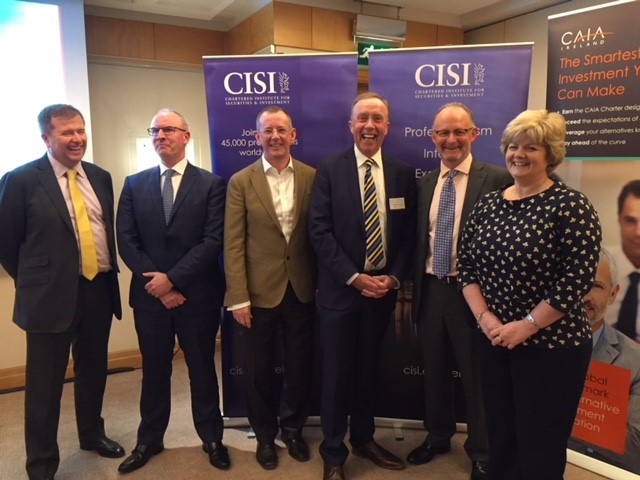
A red button issue for investors, investment managers, consultants and regulators as evidenced by a huge attendance at the session. Thoroughly engaging evening as performance was analysed and the future of the asset category considered. CISI Ireland assembled a top quality panel of managers, consultants and fund selectors, from Ireland and the UK, to discuss.
Panel members L-R Chris Nicholls, David Ryan - Chairman, CAIA, Rory Gillen Frank O’Riordan CISI President, Joe Mottley and Sara Morgan
Sara Morgan, Blackrock: Sara began by clearly outlining the differences between Absolute Return and Total Return investment objectives. Focussing on absolute return it was clear there was a performance issue. Sara singled out 2018 and 2015 as being particularly poor. What lessons could be learned? Expectations were set too high. Costs were underestimated. Sara also felt there had been capacity issues in some asset classes given the unprecedented growth. The liquid Alts category she feels is a very mixed bag.
For Sara there is still a role for Absolute Returns (AR) going forward, especially as in her view we should see more dispersion and lower correlation between asset classes, given we are seeing the end of the QE experiment. However there is a need for better communication and education in the future, and above all a need to manage expectations. Investors do need to have a longer time horizon and be aware of the risk of significant drawdowns along the way.
Rory Gillen, GillenMarkets. Rory very much drew on the facts. Rory looked at data from 1998 to 2018 and highlighted the period 2003 to 2018 as being especially disappointing for Absolute Return. He believes low interest rates, high costs and too much capital chasing specific strategies as key drivers of the underperformance. If we expect long term equity returns to be 5% over inflation, he cannot see AR with higher costs and targeting lower risk (volatility) being able to offer similar return profile. There is no evidence and he feels the case for inclusion of AR in multi-asset strategies is weak.
Chris Nicholls, Aberdeen Standard LIfe: Chris felt that there had been a definite change in market circumstances since the financial crisis and managers should have been more vigilant in communicating that to their clients. Market features didn’t help AR – in 2017, as risk assets performed and in 2018, as practically all asset classes were negative, diversification didn’t reduce risks. As managers they should also have been more aware of changes in the “financial plumbing” in the system, especially the degree to which Central Banks were including market sentiment in their decision making. Chris still sees a role for AR into the futures and cites broader investment freedom with use of asset classes such as Private Equity , Aircraft leasing etc as a possibility.
Joe Mottley, Clarus Investments: They have become disillusioned with the performance of AR. He cited the FT definition of AR as positive returns in all market conditions with lower risk as probably what most people thought they were buying into. This hasn’t happened. Joe produced some forensic data on an Irish AR peer group of funds, and his findings were
- Costs were higher but only about 35 basis points on a median basis.
- Correlation with equity markets was higher than expected.
- Volatility generally was well managed.
Poor decisions were made at different times – not enough hay was made when the going was good. In 2016 and 2017 many AR funds had a big structurally bearish view which they didn’t unwind. A lot of damage was also done in 2018 as many asset classes were negative and despite their ability to short this was a headwind for AR managers. Clarus view is that the declared objectives of AR funds is too high and that instead an AR fund delivering 1 or 2% over cash could work.